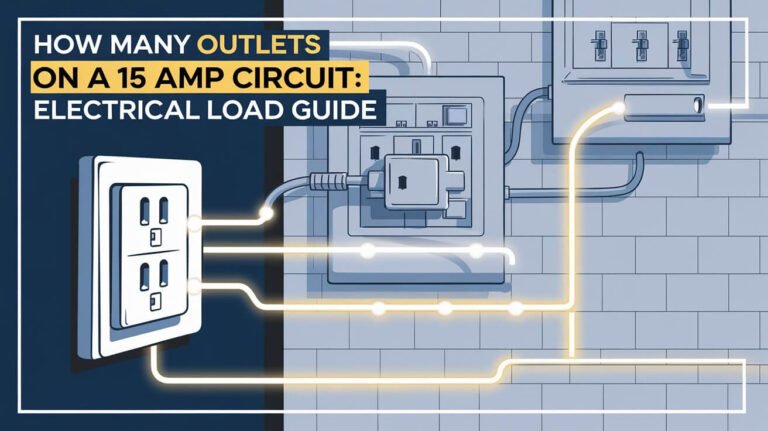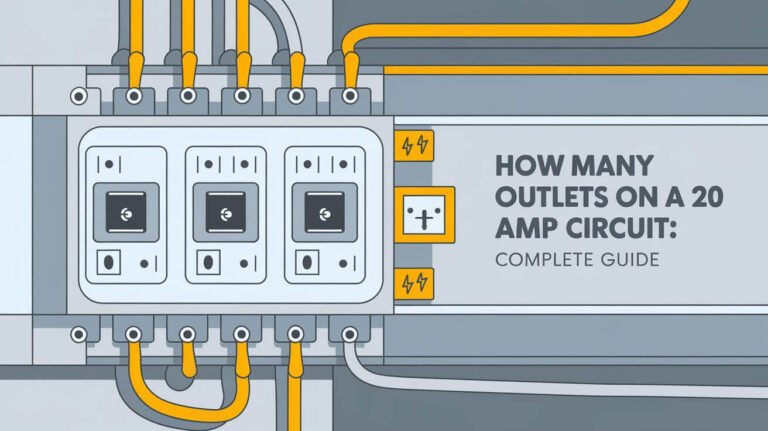
A parallel circuit has two or more paths for current to flow. It has multiple branches that connect to the same voltage source. This setup is great because if one part fails, the others keep working.
The voltage stays the same across all parts. But the current splits among the branches. This makes parallel circuits useful in many areas.
They are found in homes, cars, and electronic devices. Knowing how parallel circuits work is key to making electrical systems safe and efficient.
What Is A Parallel Circuit
A parallel circuit is a setup where parts are connected in many paths. This lets current flow through different paths. It’s different from a series circuit, where parts are connected one after another.
Components and Multiple Paths
In a parallel circuit, parts are connected to the same terminals. This lets each part work on its own, with its own path for current. The current splits and flows through these parallel wiring paths, making independent loops for electricity.
Basic Structure and Flow
A parallel circuit has a power source like a battery or generator. Each part has its own path for current. The current divides as it goes through different paths. This current division lets parts work separately, getting the same voltage equality.
Power Distribution Fundamentals
Parallel circuits are great for even power distribution. Since all parts are connected to the same voltage, they get the same power. This makes them perfect for places where steady power is needed.
Key Characteristics of Parallel Circuit Design
Parallel circuits have unique features that differ from series circuits. In a parallel circuit, the voltage stays the same across all parts. This is because they are connected to the same terminals. So, the voltage drop across each part is the same, no matter its resistance or current.
The total current in a parallel circuit is the sum of each branch’s current. This makes it great for sharing loads. It also makes it easy to add new parts without big changes in voltage.
- Parallel circuits are also fault-tolerant. If one part fails, it doesn’t stop the others from working. This keeps the circuit running smoothly.
- The total resistance of a parallel circuit is always lower than any single branch’s resistance. This is because there are more paths for current, leading to less overall resistance.
These special traits of parallel circuits make them perfect for certain jobs. They’re great for load sharing, fault tolerance, and keeping current flow stable. Knowing how to calculate resistance in parallel circuits is key for making reliable and efficient electrical systems.
Voltage Distribution in Parallel Configurations
In parallel circuits, the key idea is that voltage is the same everywhere. This makes power distribution and load management work well. Each part gets the current it needs without affecting others.
Equal Voltage Principles
The power source keeps the voltage the same, and current changes with each branch’s resistance. This setup helps balance the load, letting each part work alone. The steady voltage is a big plus, making power supply stable and reliable for all devices.
Power Source Impact
The power source is vital in parallel circuits. It must give the right voltage and current for all parts. A good power source keeps the voltage steady, even when the load changes. This keeps the circuit running smoothly and prevents voltage drops that could harm parts.
Load Management
- In a parallel circuit, the voltage equality principle allows for effective load balancing.
- Each component can draw the current it needs without affecting the others, ensuring efficient and reliable operation.
- This configuration is beneficial for consistent performance, as one part failing doesn’t stop the whole circuit.
The even voltage distribution in parallel circuits is a big plus. It makes power delivery efficient and lets parts work alone without trouble. With a stable voltage source and smart load management, parallel circuits offer a dependable and flexible power solution for many uses.
Current Flow and Branch Distribution
In a parallel circuit, current flow is key to grasp. The power source’s total current is split among branches. Each branch gets a different current amount, based on its resistance. This setup lets designers pick components freely, without impacting the circuit’s overall function.
What makes a parallel circuit special is the even voltage drop across each branch. This means all connected parts share the same voltage. But, the current in each branch can change a lot, depending on its resistance.
| Characteristic | Description |
|---|---|
| Current Division | The total current supplied by the source is divided among the parallel branches, with each branch carrying a different amount of current based on its resistance. |
| Voltage Distribution | The voltage drop is uniform across each parallel branch, ensuring that all components receive the same voltage. |
| Branch Currents | The current in each branch is inversely proportional to the resistance of that branch, following Ohm’s Law. |
| Total Current | The total current supplied by the source is equal to the sum of the currents flowing through each parallel branch. |
| Total Resistance | The total resistance of a parallel circuit is less than the resistance of any individual branch. |
Calculating the total current in a parallel circuit is crucial. It helps decide the right size for the power source, wiring, and other components. Knowing how current divides in a parallel setup helps designers make sure the circuit works safely and efficiently.
Resistance Calculations in Parallel Circuits
Understanding total resistance in parallel circuits is key to circuit design. The formula is simple: 1/Rt = 1/R1 + 1/R2 + 1/R3 + .... This shows that Rt is always less than the smallest resistance. Knowing this helps grasp how power and current are distributed in parallel circuits.
Total Resistance Formula
The total resistance in a parallel circuit is found by taking the reciprocal of the sum of all resistances’ reciprocals. This formula is crucial for circuit designers. It helps them figure out the system’s overall resistance, which is vital for power distribution and current flow.
Branch Resistance Relationships
In a parallel circuit, voltage stays the same across all branches. Current, on the other hand, splits among the paths. This makes branch resistances key to current flow. Knowing these relationships is essential for improving parallel circuit performance.
Practical Applications
Parallel circuits are used a lot, like in household wiring and industrial equipment. They keep voltage constant while letting different parts use different currents. This makes them great for powering many devices safely and efficiently.
Questions Everyone Asks
What is a parallel circuit?
A parallel circuit has more than one path for electricity to flow. It has many branches that connect to the same power source. If one part breaks, the others keep working.
The power source’s voltage stays the same for all parts. But, the current splits up among the different paths.
What are the key components and structure of a parallel circuit?
Parallel circuits have parts connected in many ways. Each part has its own path for electricity. This setup is like a river splitting into streams that then come back together.
It makes sure each part gets the same voltage. This helps with sharing power and adding new parts easily.
What are the fundamental characteristics of parallel circuits?
Parallel circuits have a few key traits. The voltage is the same for all parts. The total current is the sum of each branch’s current. And, the total resistance is less than any single branch’s.
They can handle failures well, as one part not working doesn’t stop the others. Adding new parts is easy without big changes in voltage.
How is voltage distributed in parallel circuits?
Voltage is the same for all parts in parallel circuits. This makes power sharing and managing loads efficient. The power source keeps the voltage steady, and current changes based on branch resistance.
This setup helps balance the load. Each part gets the current it needs without affecting others.
How does current flow and divide in a parallel circuit?
Current splits up among branches based on their resistances. The total current from the source is the sum of each branch’s current. This lets you choose parts and design circuits flexibly.
Each branch can have a different current, based on its resistance. But, they all have the same voltage.
How is total resistance calculated in a parallel circuit?
To find total resistance in parallel circuits, you use reciprocals: 1/Rt = 1/R1 + 1/R2 + 1/R3 + … The total resistance is always less than the smallest individual resistance.
This formula is key for designing and analyzing parallel circuits. It’s used in household wiring, where appliances connect in parallel to keep voltage steady while drawing different currents.






